


During our visit to Media Molecule's offices last year for our November cover story, the developer stood firmly behind its intentions with Dreams: Create the most accessible and deepest video game creation tool available to a mainstream audience. It was a bold statement, but one that the various demos (and later, closed beta) showed that maybe the developer of LittleBigPlanet and Tearaway could pull off its wild ambitions.
The creation suite of Dreams is now out in Early Access, meaning anyone who pays $30 while spaces are still open for the game can get their hands on the full toolset. For the next week, I’m going to be taking Dreams for a spin, work diligently with the tools to see what I can create in that period of time. The goal here isn’t necessarily to create something amazing (wouldn’t that be swell!) but instead to see what someone with little-to-no game creation experience can do with those tools if they’re willing to put in the work.
Just so you have an idea of where I’m coming from experience-wise: I’ve created and released a few text adventures and a visual novel for commercial purposes. I understand a little bit of Python and have experience creating word-heavy games based on choice and consequence. However, I have never created art assets, have never made music, haven’t experimented with artificial intelligence, and have never dabbled in Unity, the Epic engine, or anything similar. I imagine I’m likely going to be stumbling a lot and will be writing frankly about my follies (hopefully my screw-ups prove amusing). At the end, what I hope emerges is a fairly accurate portrait of what one can expect if they take the deep dive into Media Molecule’s Dreams.
With that in mind: it’s showtime, folks.

As soon as Dreams’ cutesy introduction sequence, letting you name your imp (the cute little cursor you’ll be using to manipulate the world) and teaching you the basics of moving the camera, I make a beeline for the creation toolset. My logic is that I already saw the ins and outs of how to move and manipulate objects in Dreams’ creation space during a few preview sessions at Media Molecule and thus should be fine learning on the go while messing with the tools.
I quickly pay the price for my arrogance.
Plucking a humanoid sculpture from the game’s huge collection of objects (both those made by Media Molecule and those crafted by Dreams users), I plant the body on top of the creation space’s huge tile of space. From there, I try to create shapes and shrink them down by manipulating the controller. However, this goes awry quickly for two reasons.
The first: Dreams’ shortcut interface is complicated, with you having to combine buttons like L1 with another to do certain things to objects (like shrinking them or spinning them in a space), so it’s easy to lose track of all the commands at your disposal. The second reason is that I’m just not used to literally moving around the screen yet. Unlike most games, Dreams requires you to navigate around the world using the motion control in your Dualshock controller. This makes sense because you’ll eventually be brushing objects, stretching them out, and manipulating them in other ways that are more suited to motion control than analog . However, my hands still get caught up in the unique scheme, my thumbs often pushing on a camera-controlling analog stick when what I want to do is move my cursor.
There’s really no way of getting around the motion control part except for getting used to it over time. However, Dreams’ commands and toolsets are so numerous and complicated that I quickly own up to the truth: there is no way I can skip the tutorials. I’m going to have to eat some vegetables before I get to the fun stuff. C'est la vie.
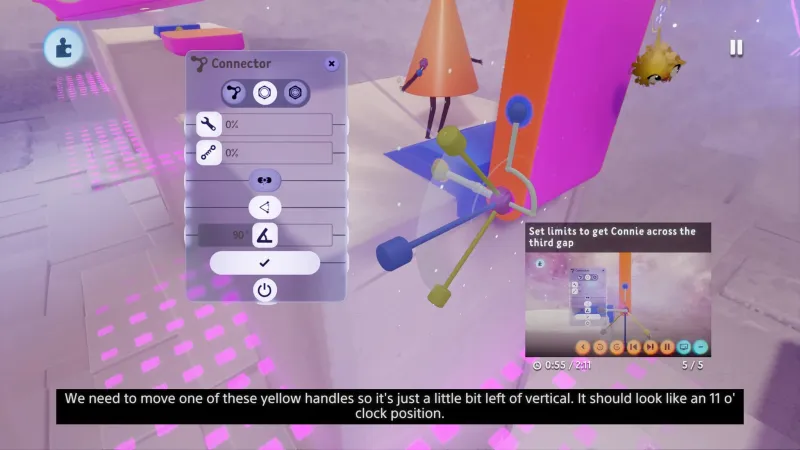
Heading over to the tutorial section, I see Dreams’ tutorials aren’t your bog standard tips or even quickplay videos showing you how to do whatever you want to do. Instead, Dreams’ presents its playable tutorials like a full on class for operating the game. There are several modules, filled with multiple lessons that average around 3-5 minutes, for basic things like manipulating the camera, sculpting objects, and creating artificial intelligence for your puppets (characters that you can fill your world with to either control or serve as NPCs).
It soon becomes clear that tutorials are going to be the rest of my night. However, the tutorials aren’t so bad. All of them are interactive, with you essentially watching a quickplay video that shows you how to do something and then following through on it yourself. Once you finish a lesson, it’s checked off, and you move on to the next one. And they are genuinely helpful too. Within the first four movement lessons, I learn shortcuts for zooming and manipulating objects that will make moving across the creation space less of a hassle.
As the lessons go on, I find myself less annoyed that I have take tackle these tutorials and more with the fact that I thought I could just bypass it all and learn on my own. Dreams’ toolset is ultimately generous in terms of how much it offers and how quickly it is to learn the ropes compared to taking several months or even years to learn C++, BASIC, Java, or an engine like Unity. Dreams is literally its own language: a set of procedures and elements that you can bend to express yourself in an exciting way. Of course there would be a learning curve.
My only concern now is that I hope that partaking in all of these tutorials pays off, especially when it comes to helping me commit maneuverability and manipulation functions to muscle memory, and that I can stumble just a bit less when I return to the creation space tomorrow, my head sloshing around with lesson after lesson on how to make the game of my dreams.
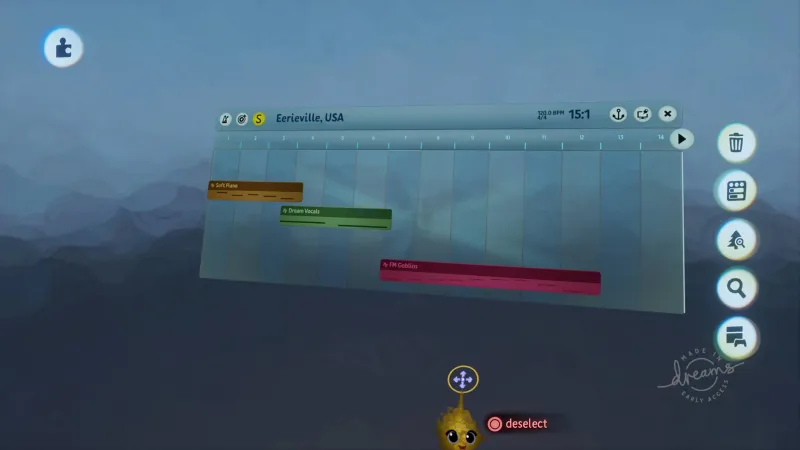
Reader, the mind boggles at the amount of tutorials in Dreams. I feel like all I've really done since starting the game is watch tutorial after tutorial on modeling, movement, and logic. I think I've had enough for a bit, so let's get to creating and start with something pretty simple.
Let's make some music.
As our time during our trip to Media Molecule attested, Dreams' music creator is vast and filled with options within options. However, it's probably the most accessible part of the toolset in that you can just fiddle around with and not have to dive into several lessons on how to use the tools at hand.
Loading into the music creation suite, we start with a mostly blank screen accompanied by a toolbar that shows us directors to all the stuff we can do. I immediately get to work in the usual, very coordinated method of how I approach all work-related endeavors: by randomly pushing buttons and hoping for the best. Surprisingly, it gets me pretty far!
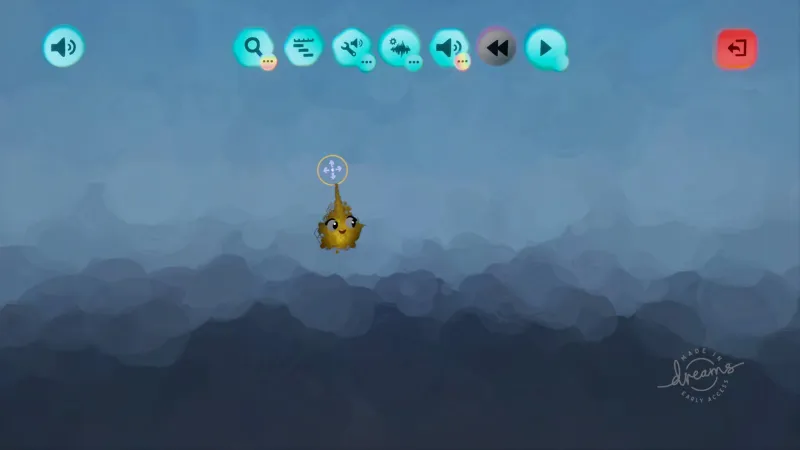
I first plot down a timeline on the middle of the screen so I have a place to stick all the sounds I'm going to be mixing together.
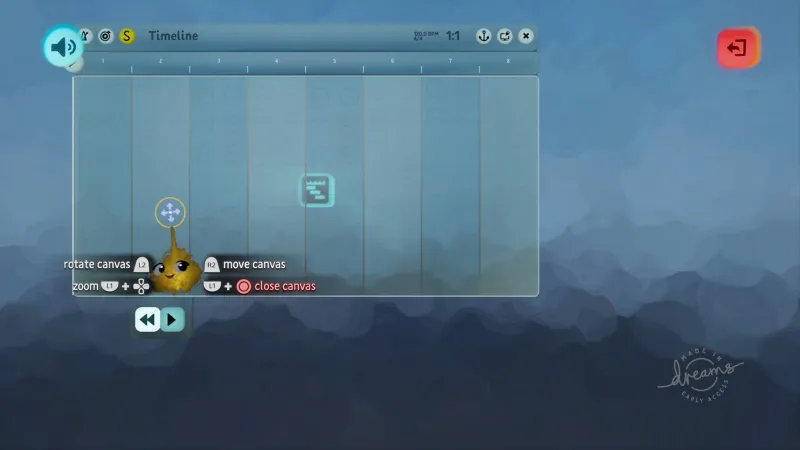
Then I dive into Dreams' collection of prebaked tunes to grab some stuff to mix together. I select, at random, a number of Media Molecule created instrument effects. The options available are kind of amazing, encompassing synthwave sound effects, drums, emulated vocals, strings, chimes, and more. If you can think of an instrument, chances are, it's here in some way. I plop down my selections on the creation screen.
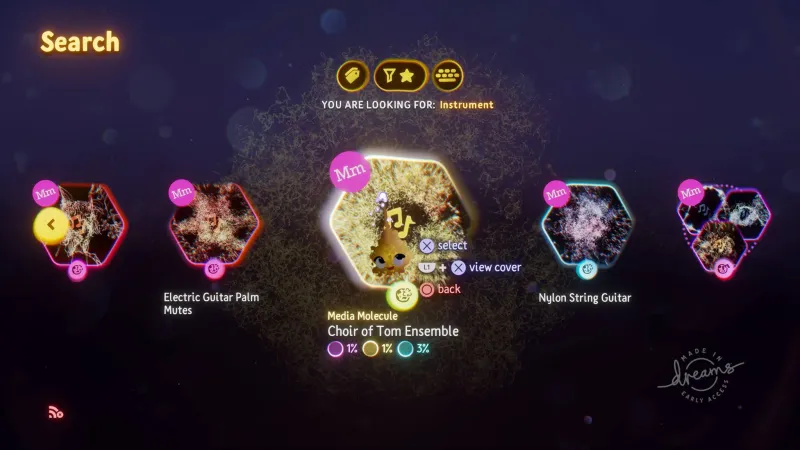
From here, I start playing around with each instrument I've selected. These aren't just sounds that you insert into the timeline to stitch together in the hopes of randomly creating a beat. You actually have to play them to create the tracks you'll put in the timeline. Here's an example of what I mean, from selecting an instrument in the Dreamiverse to actually playing it:
I spend the next 15 minutes playing around with various instruments and turning the sounds into tracks with a handy record feature. After that, I'm ready to stick them in the timeline, modifying when each track begins and ends, when they overlap, when they fade out, and so on. After a few minutes of fiddling around, I arrive at this little (creepy) ditty.
The result isn't going to set the world on fire. However: it's something that has a beginning and an end, which I made in about half an hour. I can save this song, pop it into anything else I make to play (maybe a creepy horror game at some point), or give it to anyone else who wants it. Moreover, I can refine it by getting lost in all of the music maker's options for each instrument. Check this one out for vocals alone.
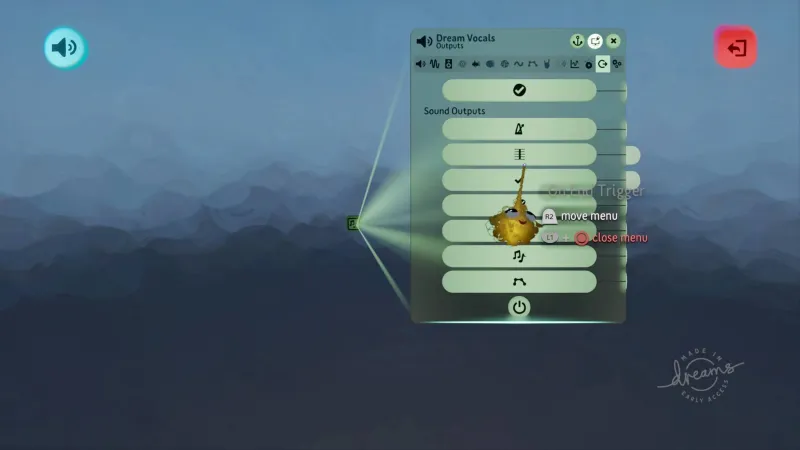
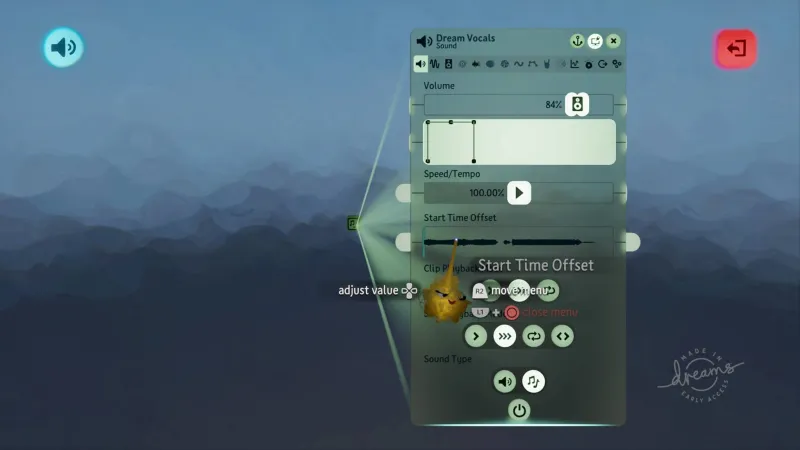
Tempo, pitch, offset, bass, and reverb are just the tip of the iceberg. I could easily lose countless hours (if I had the talent) to customizing the finest details of each instrument and the composition of the song I'm making. Maybe one day in the distant future, that will be me! However, we've only got a week here for the purposes of this exercise so for now, I'll have to make due with this little number.
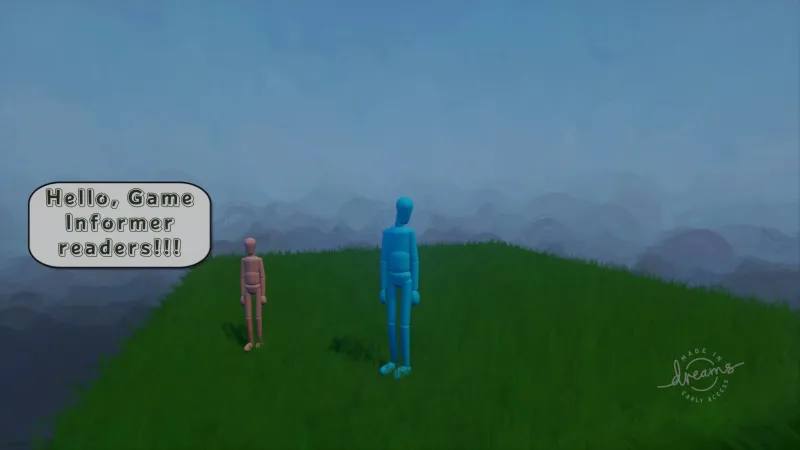
Dreams has a lot of special things humming under its hood. To me, I think the most miraculous part of the toolset are all the logic options at your disposal. In Dreams, this is your shortcut to programming. All the tools in that toolbar (which include things like triggers, health bar managers, textbox pop ups, teleporters) are visual equivalents to commands in programming languages like Python.
Today, I want show you the versatility of the trigger field. It's quite possibly my favorite tool I've encountered in the creative suite so far. In programming languages, you have something called conditional statements. A conditional statement is a command in a program that executes the following: If [insert condition is met], then [make this action happen]. The trigger field creates a 3D representation of that notion.
In Dreams, if you lay down a trigger field, you can connect it to another tool in the game to create an effect. Here's a simple example: by tethering a sound track imported or created in your Dreamspace to the trigger field, you can make it so your player character (or an NPC) activates that song when they pass through the field, causing it to play. The customization option to determine fadeout/in for said song and if it keeps playing on loop.
Here's another one. Want an NPC to perform a series of animations? A simple way of doing this by taking control of the NPC, recording you possessing the NPC and making them doing those animations (which you can configure into the character but we'll get to that later), and then tethering that recording to the field so the NPC will perform that animation when you step into it. Like this:
Want another party trick? Check this out. If you want to create a sequence where you're looking at ongoing events through the lens of a security camera (or just create a cool Uncharted-like transition), you can do that with a trigger field + keyframe combo, like so:
There's a lot of combinations you can do with just the trigger field and the gadgets at your disposal and I can't wait to continue to tinker with them (as well as the other tools of the trade) well into the night, each new discovery opening up a world of possibilities for creation.
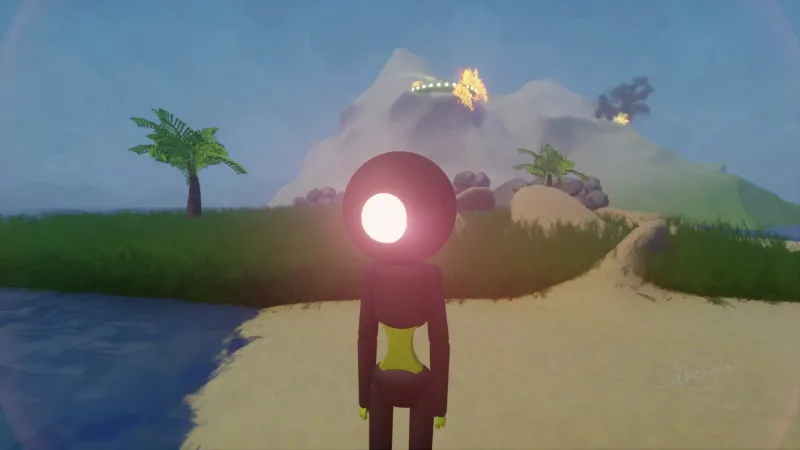
One of Dreams' central tenets is the idea of remixing. An entire social structure emulating Twitter and Youtube exists within Dreams, letting players create and share content. If a player creates a sculpture, a level, a movie, or environmental object, they have the option of opening that object up to share with the rest of the creators in the Dreamiverse. This is a godsend for those (like yours truly) who lack the artistic skill and experience to sculpt the models they wish to.
Today, I decided to create an entire level out of elements uploaded by other users. Now, that doesn't mean I just pluck them from the Dreamiverse, stitch them together, and that's the end of the day. There's a little bit more finesse to it than just a copy and paste job but we'll get to that in a second.
I open up a blank screen in the creator, with no idea of what I'm going to make. Initially, I start out with a patch of grass and then randomly scroll through the Dreamiverse collection of remixable objects. I come across a mountain and decide I like the look of it. I plant it down behind the grassy field I've created and then stretch it to 200% its original size, making it look like an actual mountain in my world. OK, a lawn, a mountain, what next? Why not a beach?
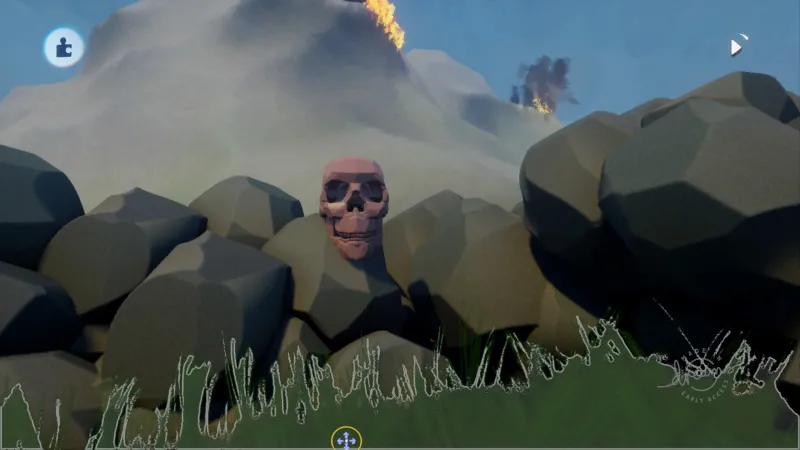
I grab some realistic ocean textures from a handy-dandy collection of water textures some nice soul in the Dreamiverse put together and slap it down at the edges of my world, expanding their size and connecting the various pieces to make them look as uniformed as possible. Then I grab some palm trees, a sand bar, and a sun and decorate my world with them as well.
The real artistry here is remembering that your goal is to create an illusion. Everything doesn't have to stitch together just perfectly (especially with the controller's habit of shaking and moving your cursor -- a steady hand is nearly impossible with the Dualshock). Instead, you've got to get clever. For example: to connect my grassy beach to my mountain in a convincing way, I dig up a single rock object from the Dreamiverse, plant about 20 of them down using the clone tool to create an obvious gate between the grass and the mountain. Then, and this is important, I make it look somewhat convincing by grabbing individual rocks and manipulating their size and rotation, so they some jut out, some are bigger than others, and so on and so forth. What I end up with is a convincing, natural-looking placement of rocks you might find at the bottom of a cliff. All of this, from blank screen to a mountain with a fully formed beach, takes about 20 minutes.
And then I decide to get weird. I plant a skull on top of my rock gate, but that's not quite weird enough is it? Let's go full hog weird. I quickly do a search for a UFO and lo behold, there are multiple UFO sculptures in the Dreamiverse. Grabbing one, I pull it into my world, expand it to 150% its size, and then stick into the mountainside to make it look like it's crash-landed. Doubling down on that notion, I grab some convincing-looking fire and smoke effects from the Dreamiverse and plant them around the UFO, mountain, and even on the beach and the sea.
Remember what I said about the illusion stuff? After I plant all of the fires, I try to find some wreckage rubble in the Dreamiverse but there's nothing. There is some building rubble, so I grab that, and plant it just beneath the fires in the sea so you can see some kind of rubble but you can't really make out it's bricks and rods. So, basically, the building rubble will work in a jiffy if you can hide it a little bit. So much of creation in Dreams, just like real-world game development, is about smoke and mirrors.
After the fires are planted, I decide to grab an alien-looking fellow (luckily there are a bunch of characters that fit the build in the Dreamiverse) to serve as the protagonist of this little level. I plant him down, enter play mode, and presto: I have a goofy looking island that an alien has crash-landed into. There are no objectives, no bad guys to fight, no goals. It's just a set piece right now but maybe later on I can turn it into a level, using logic gadgets and such. Already I'm wondering about what I want to do with these assets. What game could this be? An adventure? A shooter? A puzzler? What's the goal? Getting off the island? Sending an SOS?
I'm going to need to think about this.
Special thanks to
Brantore (UFO, Realistic Waters assets)
dsgrue3 (Alien assets)
Espn_tf (Skull asset)
Lidas (Mountain asset)
Sackchief (Sun asset)
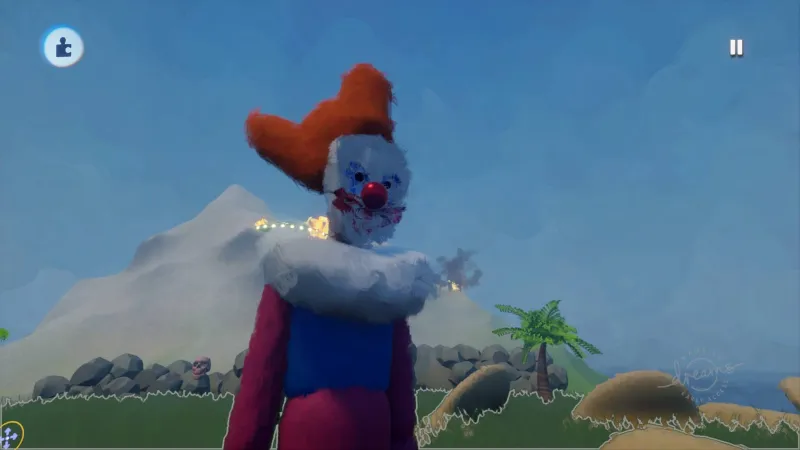
Eventually, in all sorts of creation, you reach a point where you can't take shortcuts. I think I finally hit that wall in Dreams today. The plan I started out since yesterday was that I wanted to spawn a foe for my alien to evade. The idea is that you'd have to reach a point on the island while a scary enemy chased you.
I chose a clown naturally. And then I had him threaten you, by planting a dialog box that popped up whenever you triggered the field in front of him, like so:
However, things began to fall apart shortly after that. I rigged a boat I planted earlier with a possession record tool and zoomed it across the speed. In theory: stapling a trigger to the boat and connecting it to that animation recording should make it carry the player across the sea to the edge of the screen (and away from our nefarious clown). However, in practice what happened is that trigger switches fell through the boat because the boat isn't actually a physical object.
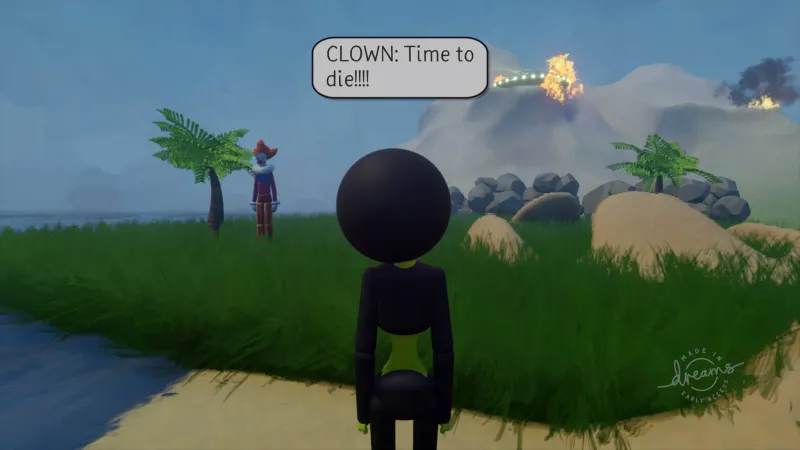
When that happened, I twiddled with the properties to make it one. I ran the scenario again. However, when my character boarded the boat, it would not move. What would move was the oars attached to the boat or, sometimes, the boat would serve as a catapult, launching my hero across the sea, which is technically an escape but not the one I want. Loading back into edit mode, I see that for some reason I haven't figured out, that the triggers were thrown from the boat onto the beach. I try stamping them in the hull of the vessel. They still get thrown.
Oh well. In the end, I decide that it's probably time to go back to the tutorial section in Dreams (and maybe even visit some detailed tutorials on YouTube about logic). However, I don't really feel defeated or anything. In fact, I feel spurred on to figure out how to do all the things that I want to do with the creation suite: A.I. mapping, configuring animations, and making music that doesn't suck. It's unlikely that I'll be able to do any of those things in a week but even the frustrating lows of Dreams play out in such a way that I feel compelled to soldier on and figure out solutions rather than hang up my tools.
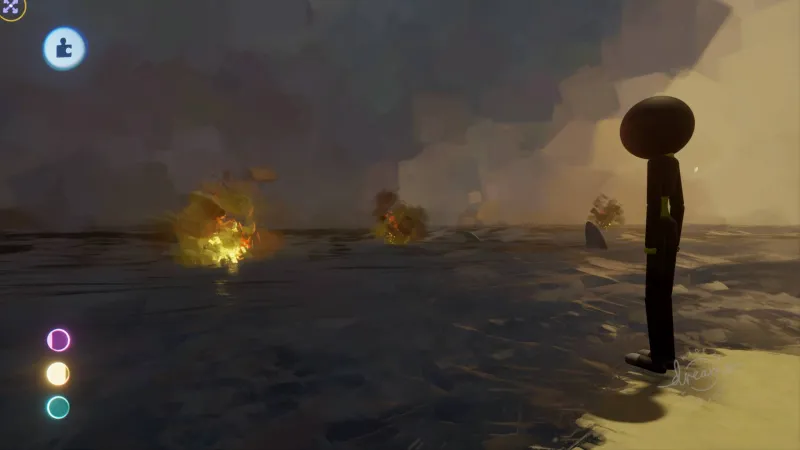
The best way to approach Dreams, I've decided, is with a Bob Ross-level of zen and acceptance of reality. There's just no way I can make a fully functional game that I want to make within the amount of time I have left during this week. However, that's not really a bummer. I don't feel discouraged. In fact, after this experiment is over, I want to keep playing with Dreams' toolset until I can make something spectacular -- even if it takes me a long time.
However, for the bit we have left, I've decided that I'm going to focus on the level that I've made and even flesh it out some more, turning it into a nice set piece. Why should our alien friend have to escape, after all? Perhaps Earth can be a nice place for him. Let's make it a decent new home, yeah?
I start with some starfish and coconuts, because you can't really have a tropical island without those, yeah? And then a boombox and beach ball, because duh. But something's missing. Something important. Something absolutely vital to our wanderer's comfort. Ah, yes. A giant penguin.
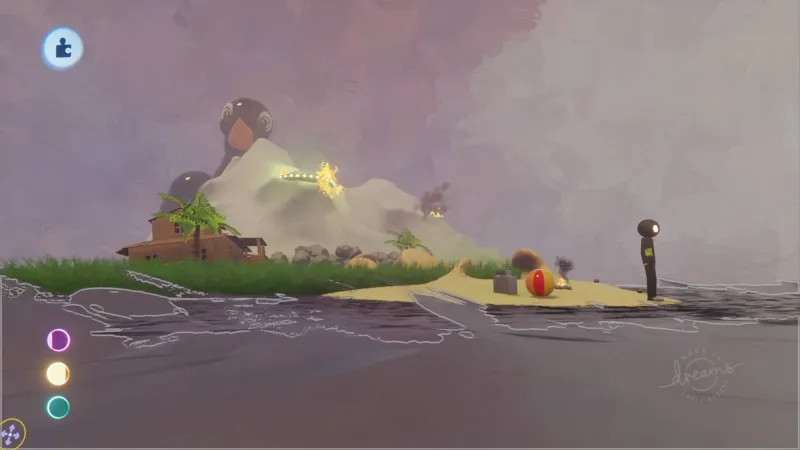
That's better.
After that, I plant a shark a player made in the Dreamiverse in the water near the beach and discover, to my surprise, you can actually control him!
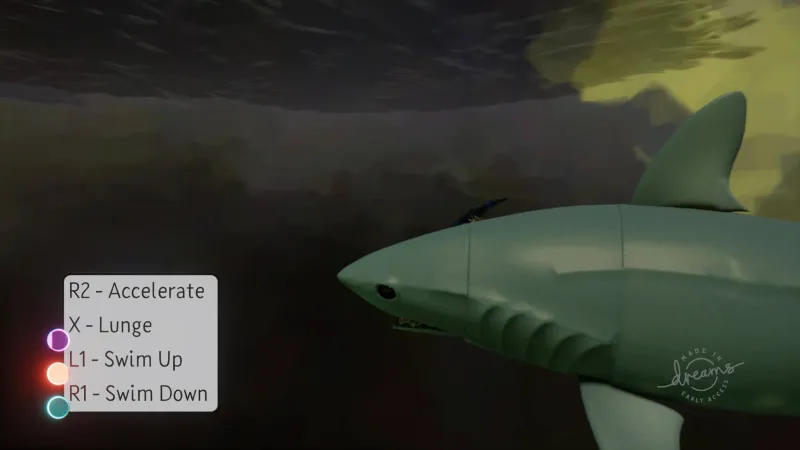
However, I actually just want him for his fin to create scenery. Sorry buddy:
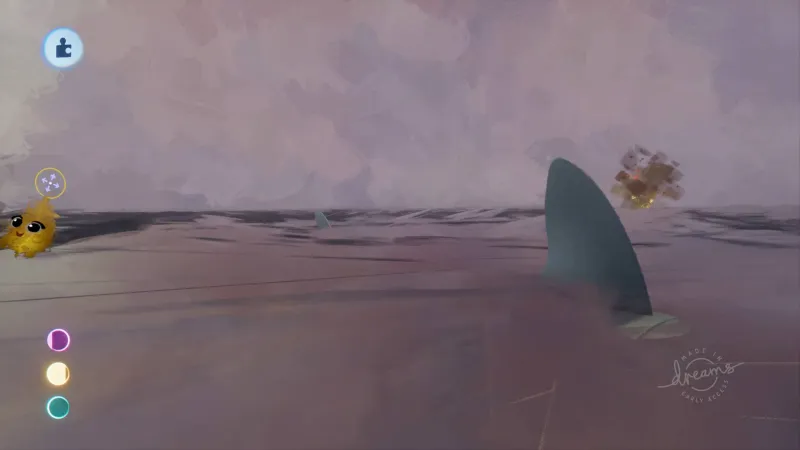
Once that's done, I put down a campfire near our alien pal and decide that we're going to change the time of day to make that fire pop. Popping into the Dreamiverse and find a night sky world state I can paste into mine. Doing that, I discover that it makes everything looks much more ominous and kind of awesome.
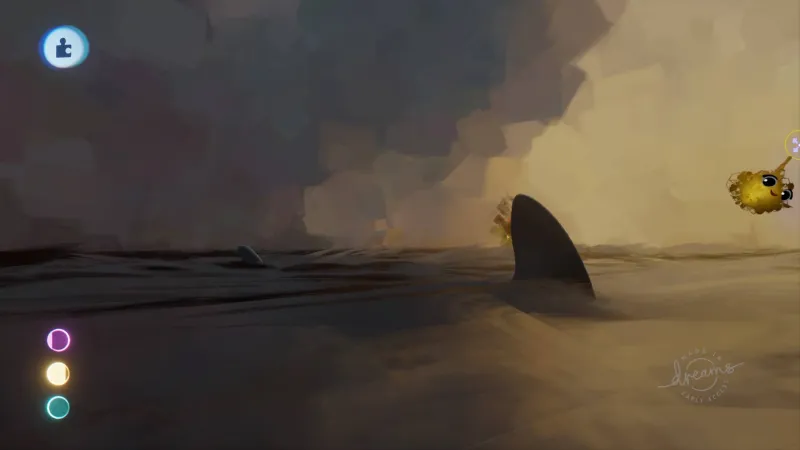
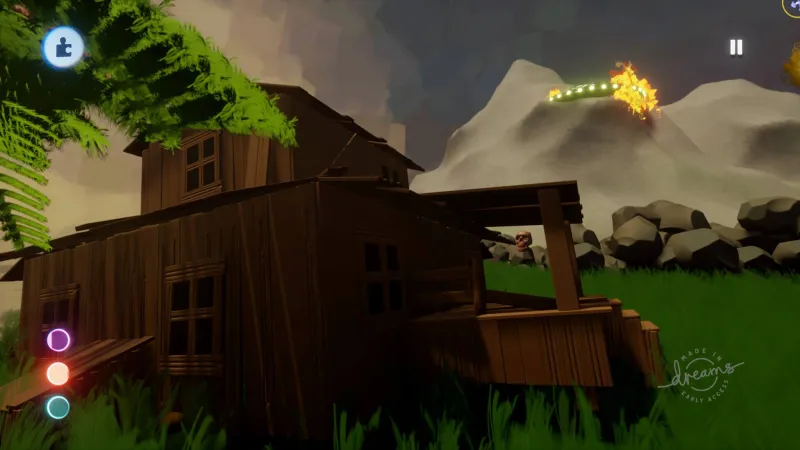
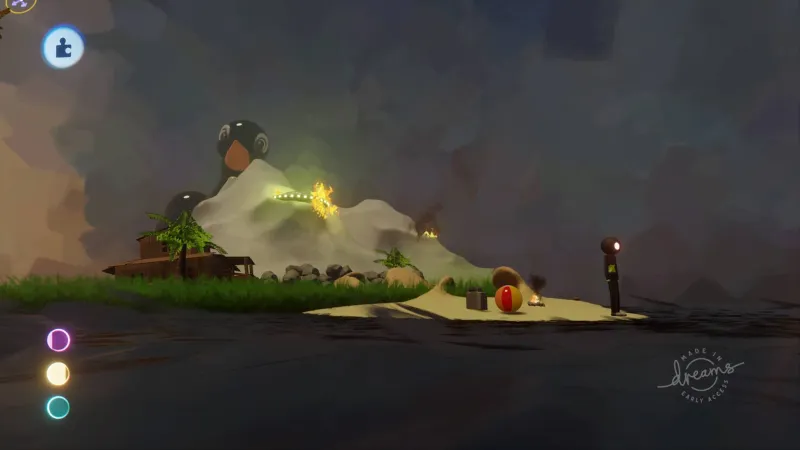
It's amazing what a little lighting can do, huh?
Not quite content to leave my little buddy alone, I decide to give him a friend. Searching the Dreamiverse, I find another fellow, we'll call him Fredrick, and plant him in the world. He seems nice. Real volleyball enthusiast, this one.
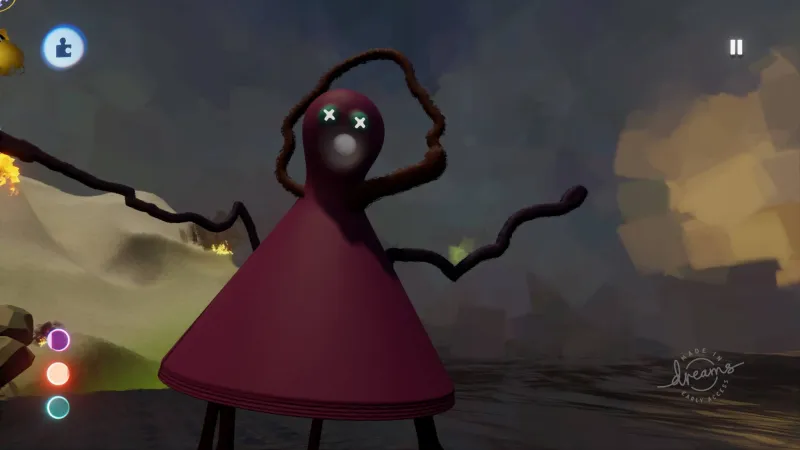
And that's that for this little scene, I think. Looking at it, I'm happy. It's weird but unique and coveys a combination of oddity and somberness...with a side of giant penguin. What's not to like?
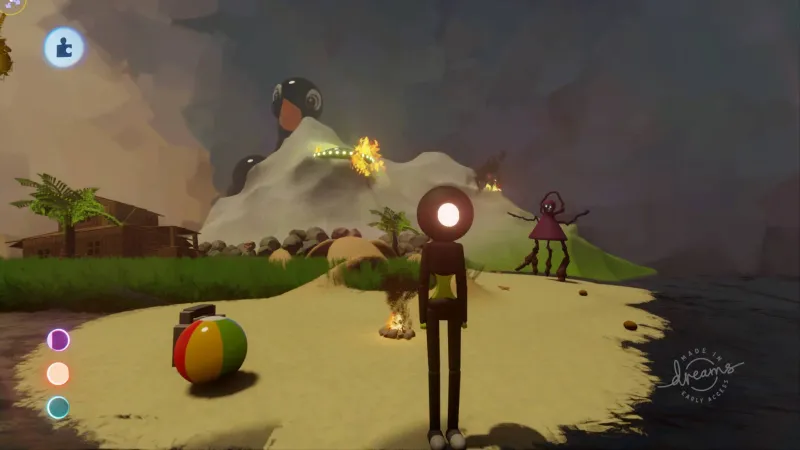
It's here: we've finished this week at long last. I didn't get to make a fully-functional game complete with RPG systems, branching dialog, and shiny attack animations. However, I don't think that's ultimately the value of my time with Dreams thus far. Instead, the game has helped further my confidence that the once mystical language of game development isn't some arcane thing that's impossible for me (or anyone else to learn). The ability to walk around in my own world (and others') while simultaneously pulling back the curtain to see the interconnected logic and relationships between all the objects, the the power to literally mold shapes and place them (or to grab them from a universe filled with assets generously given by other creators) is nothing short of fantastic.
During this week in Dreams, I made a simple level (with some help from my friends' assets). I created tunes and animations, I even fiddled with logic and some of the cadets. At the end of the week, I have an odd but nice little island with a alien fellow accepting that his new place in life is on Earth, far away from the place he calls home. It's a nice foundation for whatever comes next, and I imagine that this is in fact just the beginning of whatever I want to do with Dreams next.
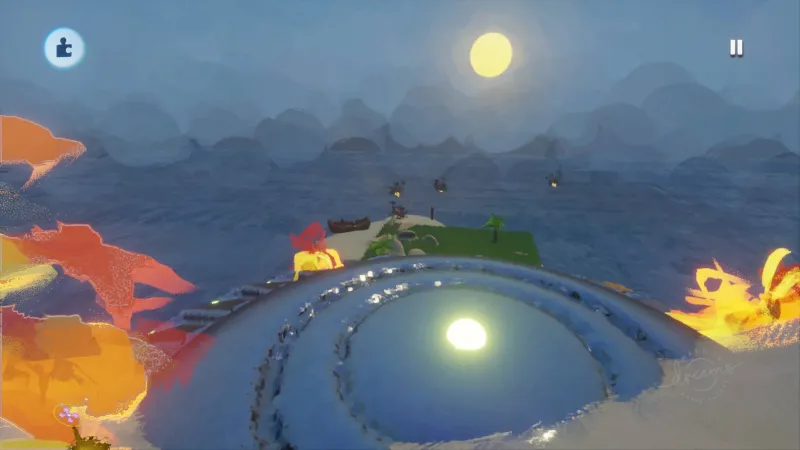
I don't see myself becoming intimidated or bored by any of the tools here. I want to learn how to string logic together, to animate, to sculpt, to create powerful illusions to enthrall players. I know I'm not alone in that because the things coming out of Dreams are already engrossing, speaking to the high-level promise of a toolset that will likely produce some must-play experiences in the year to come.
Though my weak with Dreams is over, my time with the game is far from it. Expect to hear more from me about my experience with Dreams in the months to come. There are several years of creative energy and knowledge within in this toolset, and I can't wait to make it mine.
For more on Dreams, check out my opinion piece where I argue for the game's importance.
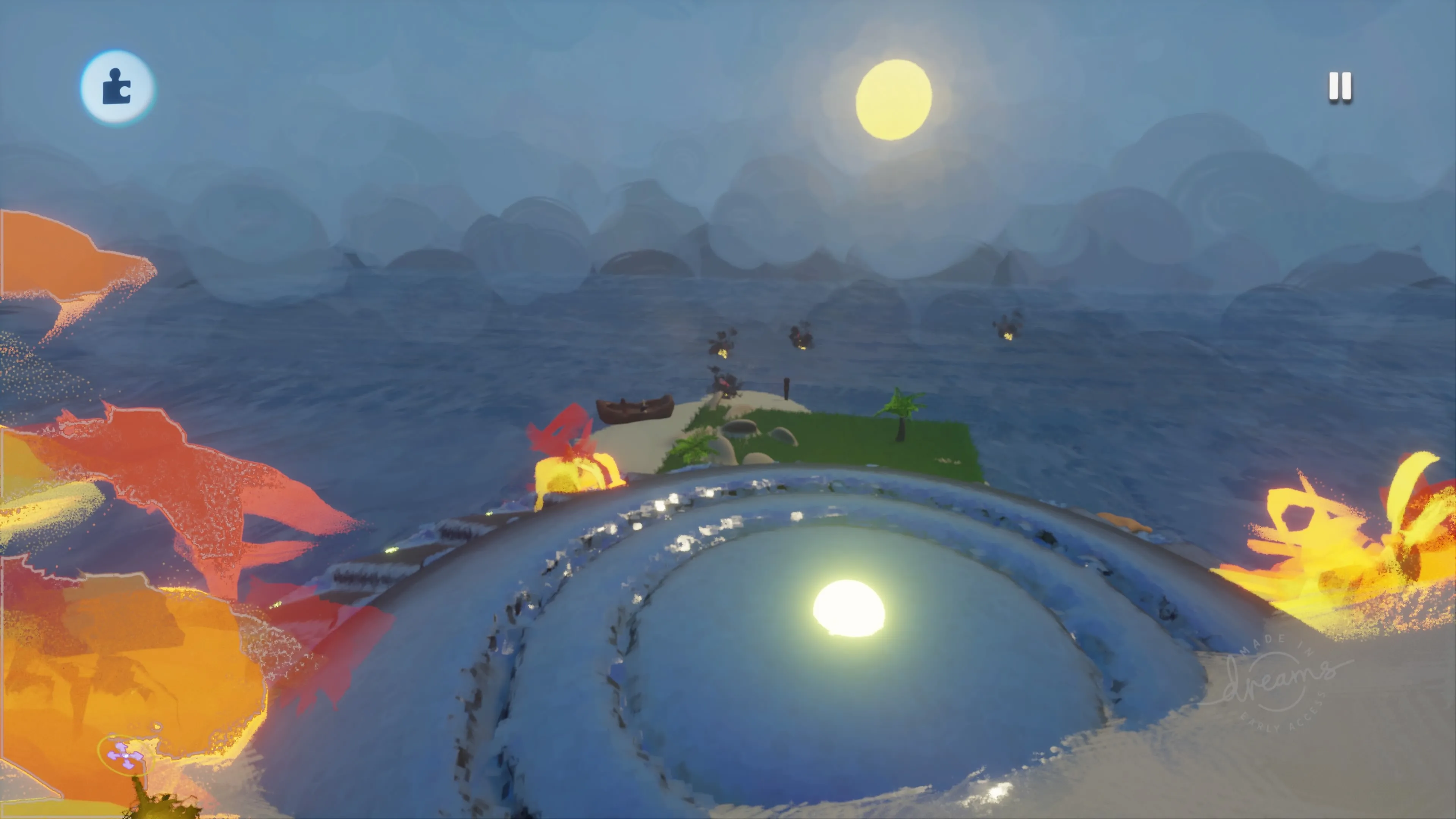
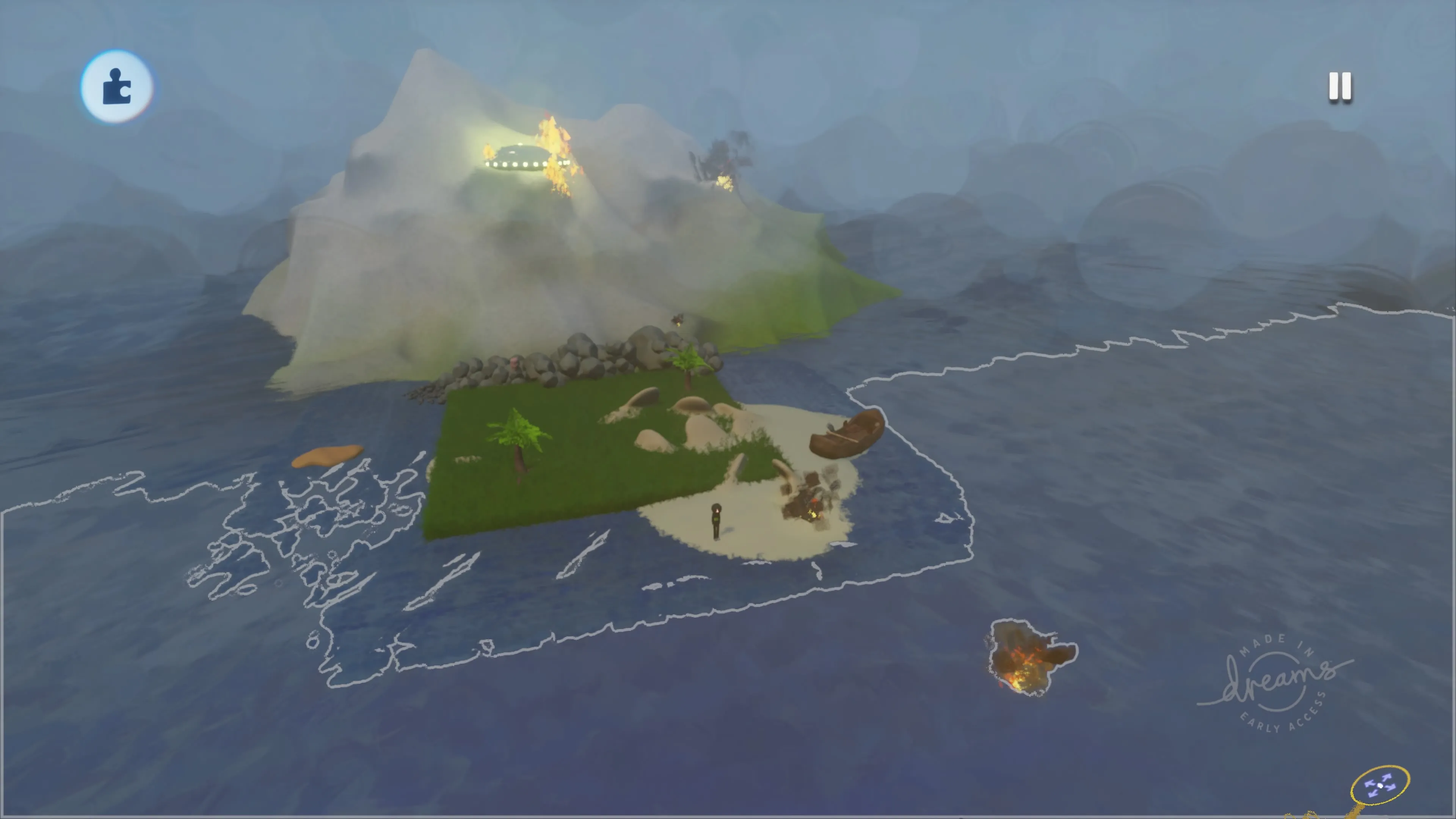

Explore your favorite games in premium print format, delivered to your door.